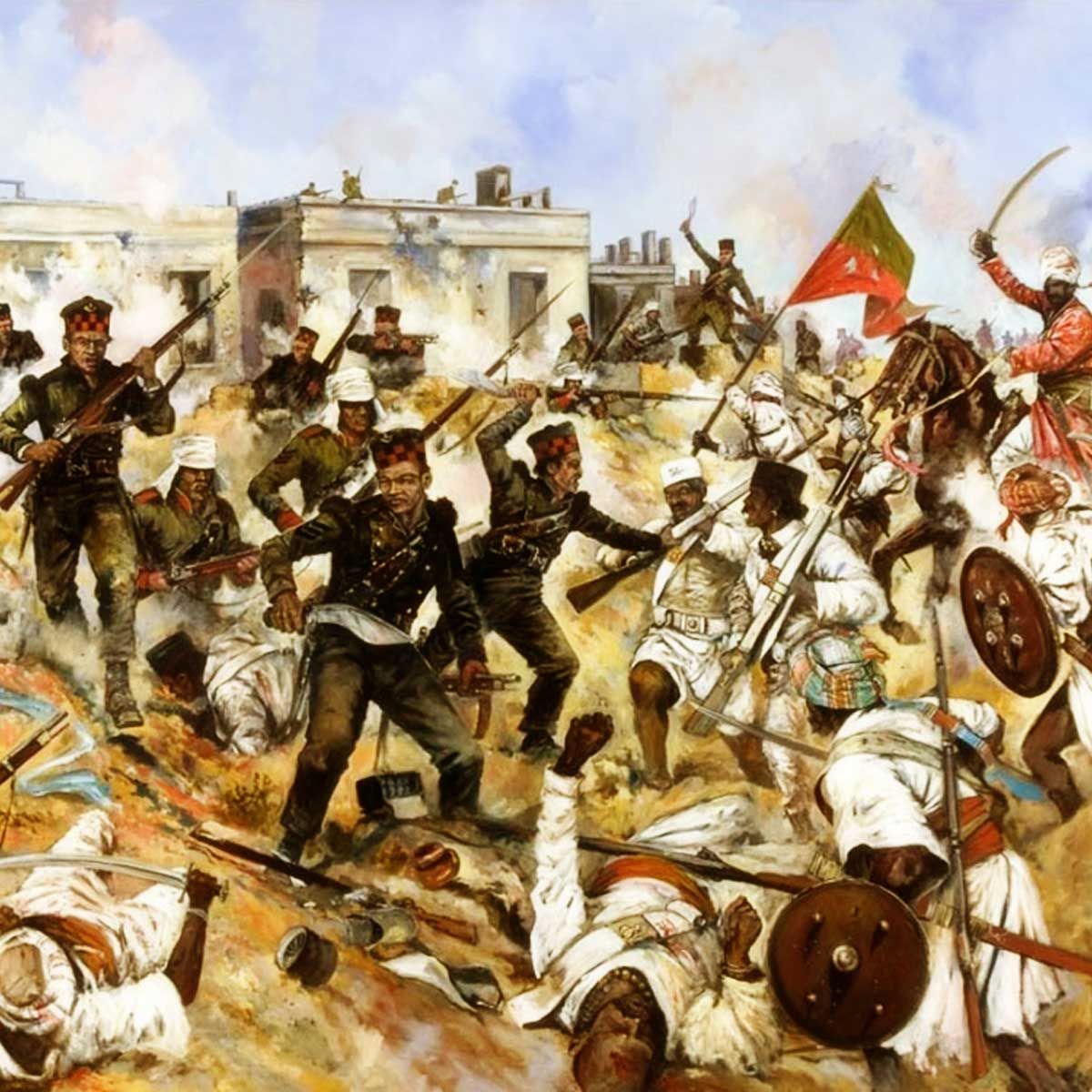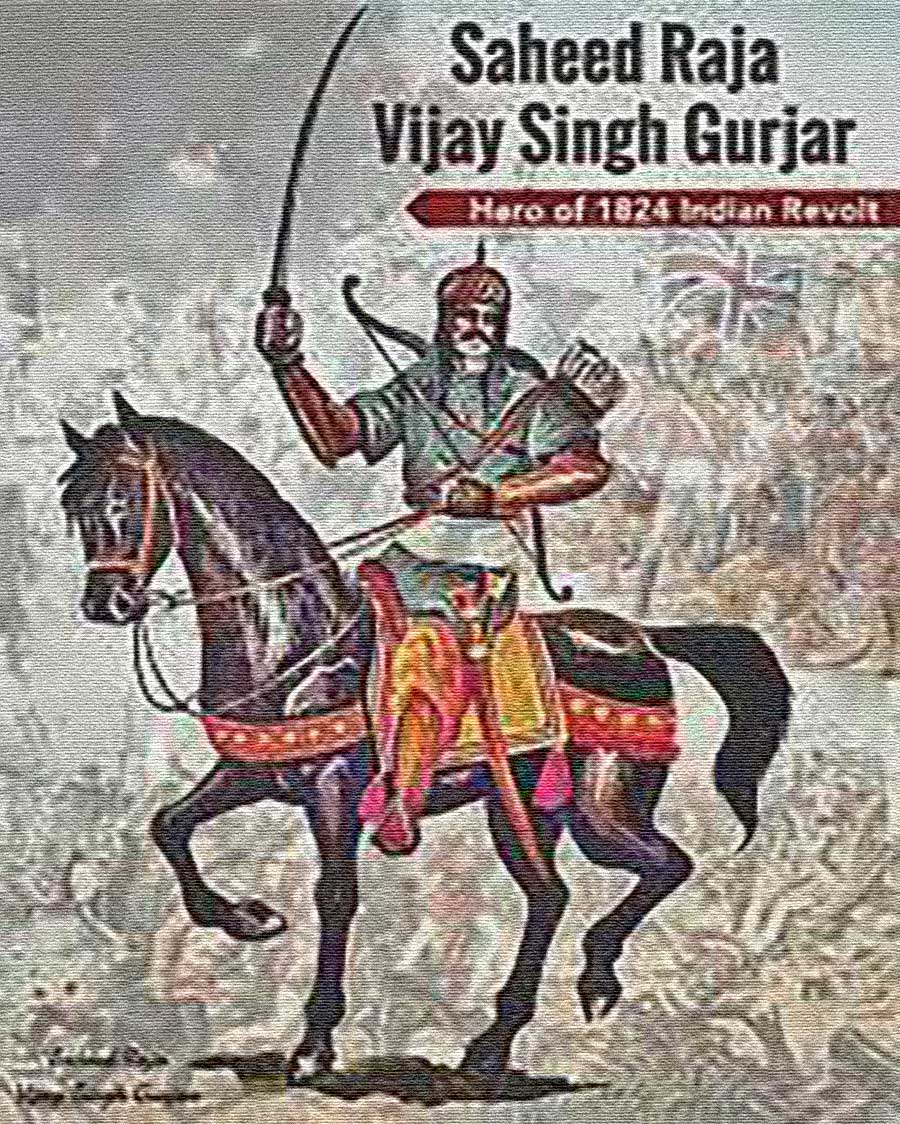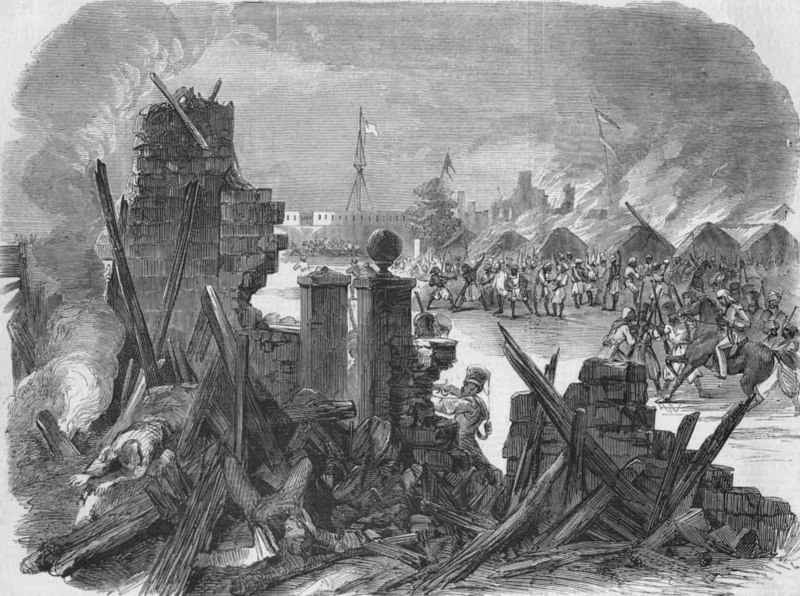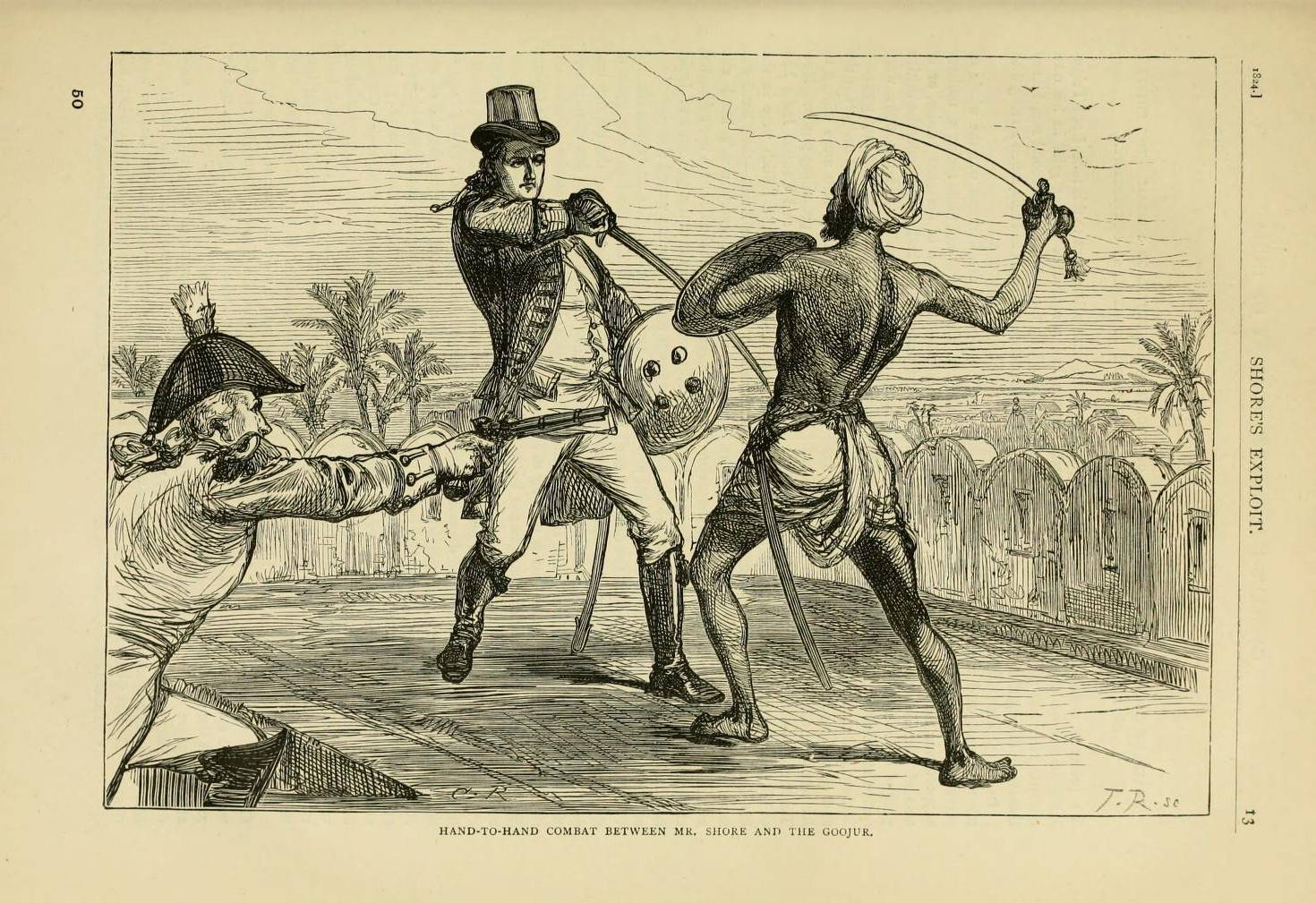More Coverage
Twitter Coverage
Satyaagrah
Written on
Satyaagrah
Written on
Satyaagrah
Written on
Satyaagrah
Written on
Satyaagrah
Written on
Join Satyaagrah Social Media
Freedom struggle of Gurjars against Britishers at Koonja in 1824: 100s of Gurjars Martyred and 100s Hung in Single Tree

New Delhi: On April 2020', the Vice President, Shri M. Venkaiah Naidu suggested that Union government should encourage states to research upon and compile the history of local heroes of freedom struggle from across the country. He also emphasized on publishing this history in local languages so as to reach the maximum people.
Speaking at an event organised in the remembrance of Shaheed Raja Vijay Singh and his brave men at the village Kunja Bahadur in Haridwar district of Uttarakhand today, Shri Naidu recalled the heroic story of the people of Kunja Bahadur who rose against the British with their king Vijay Singh.
The Vice President said that Raja Vijay Singh and his men made supreme sacrifice for the cause of freedom in 1824, three decades before the first war for independence in 1857, but it is an irony that the stories like Kunja Bahadurpur remain ignored in our history. “Our history is incomplete without the bravery of these heroes’’, he said.
 |
Mentioning the names of legendary warriors from Uttarakhand such as Ram Pyari Gurjar, Rani Karnawati, Shahmal Singh Tomar and teenage warrior Shivdevi Tomar, Shri Naidu said that our history has been witness to many a struggle wherein people rose against the invaders under the leadership of local heroes to defend their freedom, honour, culture and property.
“But these resistances hardly find any mention in our history”, said Shri Naidu adding that “we need to rectify this mistake”.
He also stressed the need to make such stories mandatory part of our school syllabus so that the new generation can draw inspiration from them.
The Vice President also called for developing a nationalistic approach to our history and research new sources for it. History does not belong to just the rulers, rather it belongs to the people and communities as well, he said emphasizing the need to study local cultural, literary and social history.
Shri Naidu said that heroic stories of local communities are transmitted from generation to generation by oral tradition and form an inseparable part of their being. “Local educational institutions, civil society organizations and media should do serious research on these oral traditions of history telling and to make the whole country aware of them”, he added.
Saying that our history is indebted to the great sacrifices made by our ancestors such as Raja Vijay Singh and his general Shaheed Kalyan Singh, he appealed to the younger generation to respect and follow their ideals.
India’s long drawn struggle to free itself from the foreign rule has been a saga of valour. The untold miseries and sufferings of those who fought for the freedom of their motherland form a glorious part of the story of resolve and yearning for self rule. The fight was not merely for political rights, but for freedom from oppression of the alien rule in all walks of life. Over the years, the freedom struggle struck deep roots across the length and breadth of the country. It drew strength from every nook and corner of the country cutting across caste and creed, region and religion.
The supreme sacrifice and selfless spirit of our freedom fighters have carved out a niche in the annals of history.
The freedom struggle is a part of recorded history, yet there are a large number of selfless, valiant freedom fighters whose contribution could not find mention or was ignored. The story of India’s freedom struggle is incomplete without these unsung heroes.
Freedom Struggle of 1824
History textbooks hardly find mention of many significant events. Before the Freedom Struggle of 1857, there were numerous small uprisings across the length and breadth of the country. One big uprising needs special mention here. It was the Uprising of 1824 where hundreds of freedom fighters, principally Gurjars bravely resisted and sacrificed their lives. It is an irony that this War of Independence of 1824 is not described in History text books. Rather it finds mention in a historical account by James Grant. Cassell’s Illustrated History of India by James Grant (1822-1887. Vol. 2. Pg 13.) finds a detailed description about the First War of Independence of 1824.
It was the year 1824. The British had by then annexed a major part of India. Koonja Bahadurpur (earlier under Dehradun and presently under Roorkee Tehsil, Haridwar District, Uttarakhand) was under the riyasat of Raja Vijay Singh. His riyasat extended as far as Saharanpur and Meerut. The Raja declared his independence and held siege of the Koonja fort. He made Kalyan Singh (Kalua) his general. He started collecting taxes.
 |
On one instance, when the British were transporting their treasury from Jawalapur to Saharanpur, escorted by 200 British soldiers, Kalyan Singh, led by his men, attacked them. The Gurjars looted the treasury and killed a number of the British forces. Soon after, British forces tried to curb the uprising, but in vain. Freedom fighters turned more active, looting and butchering the Britishers.
British forces employed Gurkhas for this task and marched towards Koonja Bahadurpur. In the words of the author of the book Cassell’s Illustrated History of India, “…On the 2nd of October 1824, an express reached Deyrah from Mr. Grindall, the local magistrate of Saharanpore, stating that part of the district has risen in rebellion that upwards of 800 men principally Goojurs, headed by a notorious freebooter named Kower, had taken possession of the ghurry of Koonja, in that neighborhood and was committing every species of atrocity. He announced his advent as Kali, the last of the Hindoo avatars, for the purpose of putting an end to the reign of foreigners. Mr. Grindal solicited the aid of 200 rank and file of the Sirmoor Battalion, which had been formed of disbanded Nepaulese in 1815; and this detachment instantly marched, under Captain Young (commanding the corps) accompanied by the Hon Frederick Shore, of the Bengal Civil Service, who with his accustomed zeal and love of enterprise, marched with the little band. Mr. Grindall joined the detachment at Secunderpore with 150 men of the Sirmoor Battalion, attended by Lieutenant Debude, of the Engineers and Dr. Royle, as volunteers.”
“After a forced march of 36 miles, these forces reached the scene of action in the Deyrah Doon, a valley through which the Ganges flows in the form of a stream, full of green islets, and fordable with difficulty, and where the forests abound with elephants, tigers, leopards, black bears, and striped hyenas.”
“The rebels were found drawn up outside the fort and along the skirts of the village of Koonja in fighting order, and they instantly opened fire upon the advancing column, which was quickly led to the attack by Captain Young….”
A fierce fight ensued between the Gurjars and the British army outside the fort. A number of Gurjars attained martyrdom. The walls of the fort were high and Captain Young’s target was to enter the fort. Escalade was impossible, as there was neither detachment nor ladders. And they had no gun to blow open the gate.
On Mr. Shore’s suggestion, a large tree was cut and its branches were lopped off by the Gurkhas using their sharp kookeries. They obtained ropes. Using the ropes and the tree, they rammed against the gate. They made several attempts. At every attempt the Gurjars attacked, thrusting long spears through the opening of the iron gate of the fort. The British opened fire. In the fifth attempt, the British succeeded in making an aperture in the gate, but only large enough to admit of entrance in a stooping posture.
Captain Young dashed through the opening attended by two soldiers and followed closely by Shore and others. In the words of the author, “As he rushed on, without having time to look about him, a man sprang from a corner of the rear, and aimed a desperate blow at the back of his neck, and would assuredly have killed him, but the quick eye of Shore, who had just reared his tall form after bursting through the aperture, saw his friend’s danger, and with the full swing of his sword, sent the lifeless trunk of the Goojur bounding past Young.” Due to the effect of the blow by the Gurjar mutineer, Young’s neck turned blue.
A fierce fight ensued thereafter. 150 Gurjars were slain by the British forces inside the fort. Meanwhile, a ‘gallant, athletic and gigantic pehelwan’, as described by the author, who by then had killed seven soldiers of the British forces using his sword and shield, came to the notice of Shore. He was involved in combat at the flat roof of a house adjoining the ramparts.
 Hand to hand combat between Mr Shore and the Goojur |
Frederick Shore approached him for a combat on the rooftop. A fight ensued between the two. In the words of the author, “The Indian was perfectly naked, with the exception of a middle cloth, and he was gaily and fantastically painted, ‘for this, his last battle’. He was armed with a sword and a shield and scornfully addressed Shore as they advanced towards each other. ‘What you too have turned sipahee to fight the Goojurs?’ The next moment their swords were seen flashing in the setting sun; but, in the combat, Shore fought at a great disadvantage, his shield having been rendered nearly useless by the loss of its corded handle, and he could only grasp the two rings to which the latter had been attached.”
During the fight Shore was heavily wounded. Kalyan Singh, the Gurjar ‘pehelwan’ was able to hit several blows with his sword on Shore’s chest. He was about to kill him when Captain Young turned up. He opened fire at Kalyan Singh. In the author’s own words, “At this time Captain Young reached the place where the two were fighting and levelled his ‘Joe Manton’ at the Goojur’s breast; the first barrel flashed in the pan, but a ball from the second pierced his chest just as he was making a desperate cut. The sharp blade swept under Shore’s unsteady shield and gashed his side at the moment his antagonist fell back dead.” Shore never recovered from his wounds. In the words of the author, “His originally robust constitution never recovered the wounds received at Koonja, though he survived till 1837, when he died at Calcutta, in his thirty-eighth year.”
|
In the fight in the fort with the Gurjars, 37 British forces lost their lives and several were wounded. They captured Raja Vijay Singh; he was later hanged at Saharanpur. Hundreds of Gurjars lost their lives. Raja Vijay Singh’s head and Kalyan Singh’s waist ( dhad ) were hung on the main gate of Dehradun Jail. Later the head was transferred to Thomson College (University of Roorkee).
The British captured the local Gurjars, especially men, of Koonja Bahadurpur. In a single day, 100s of them were hung by neck until death on a huge tree. This tree still contains the iron rings (kunde) where they were hung.
Salute to the sons of the soil, who sacrificed their lives for the freedom of the motherland.
 Support Us
Support Us
Satyagraha was born from the heart of our land, with an undying aim to unveil the true essence of Bharat. It seeks to illuminate the hidden tales of our valiant freedom fighters and the rich chronicles that haven't yet sung their complete melody in the mainstream.
While platforms like NDTV and 'The Wire' effortlessly garner funds under the banner of safeguarding democracy, we at Satyagraha walk a different path. Our strength and resonance come from you. In this journey to weave a stronger Bharat, every little contribution amplifies our voice. Let's come together, contribute as you can, and champion the true spirit of our nation.
 |  |  |
| ICICI Bank of Satyaagrah | Razorpay Bank of Satyaagrah | PayPal Bank of Satyaagrah - For International Payments |
If all above doesn't work, then try the LINK below:
Please share the article on other platforms
DISCLAIMER: The author is solely responsible for the views expressed in this article. The author carries the responsibility for citing and/or licensing of images utilized within the text. The website also frequently uses non-commercial images for representational purposes only in line with the article. We are not responsible for the authenticity of such images. If some images have a copyright issue, we request the person/entity to contact us at This email address is being protected from spambots. You need JavaScript enabled to view it. and we will take the necessary actions to resolve the issue.
Related Articles
- 21-yr-old girl Bina Das shot Bengal Governor in her convocation programme at Calcutta University, got Padma Shri but died in penury
- 16 year old freedom fighter Shivdevi Tomar, who killed 17 Britishers and wounded many
- Kartar Singh Sarabha - The Freedom fighter who was Hanged at the age of 19 and inspired Bhagat Singh
- Tirot Singh: An Unsung Hero of the Khasi Tribe who destroyed British with his skill at Guerrilla Warfare
- Unsung Heroine Pritilata Waddedar, Who Shook The British Raj at the age of 21
- Our first true war of independence lie forgotten within the fog of time and tomes of propaganda: Sanyasi Rebellion, when "renouncers of the material world" lead peasants in revolt against British and fundamentalist islamic clans
- Dangers of losing our identity: Guru Tegh Bahadur forgotten and Aurangzeb being glorified
- How Chhatrapati Shivaji Maharaj was establishing Hindu Samrajya by concluding centuries of Islamic oppression - Historian GB Mehandale destroys secular propaganda against Hindu Samrajya Divas
- A Different 9/11: How Vivekananda Won Americans’ Hearts and Minds
- History books should teach India’s civilisational, linguistic heritage, not unfounded claims: Parliamentary Committee meets to discuss NCERT books
- Chronicles of Valour- The Battle of Haldighati
- Fearless female sniper Uda Devi, who etched history during the Siege of Lucknow!
- अथ रामचरितमानस प्रकाशन कथा: गीता प्रेस, गोरखपुर ने 1938 से रामचरितमानस का प्रकाशन शुरू किया
- Rana Sanga, the symbol of bravery who defeated Sultan Ibrahim Lodhi and fought Muslim Terrorists for Hindu Existence
- A Great man Beyond Criticism - Martyrdom of Shaheed Bhagat Singh (Some Hidden Facts)
























